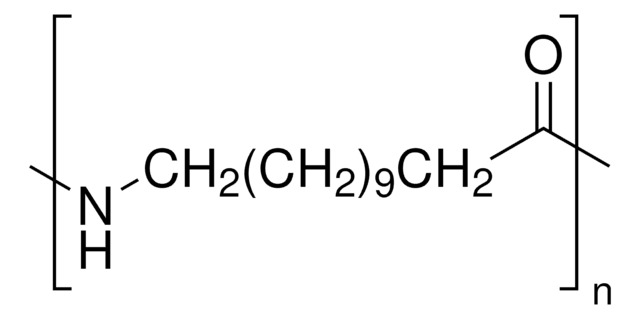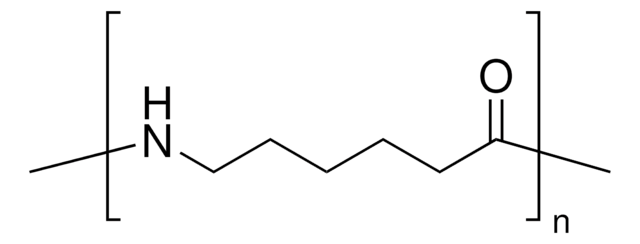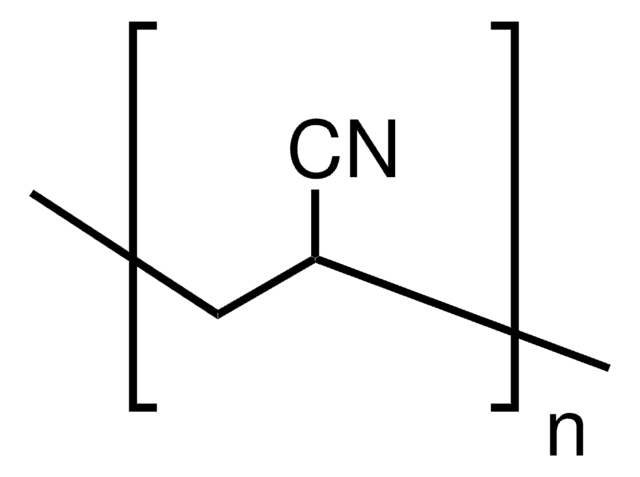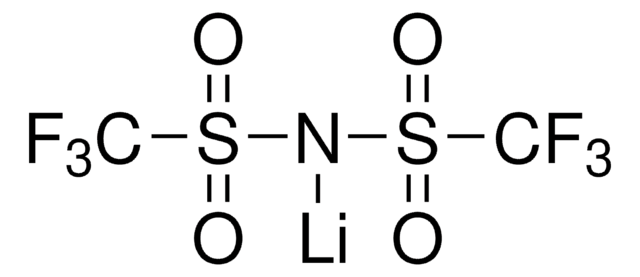182028
Poly(ethylene oxide)
average MV 600,000 (nominal), powder, hydroxyl, BHT as inhibitor
Sinônimo(s):
Polyethylene oxide, PEO
About This Item
Produtos recomendados
Nome do produto
Poly(ethylene oxide), average Mv 600,000 (nominal), powder
Formulário
powder
Nível de qualidade
peso molecular
average Mv 600,000 (nominal)
contém
200-500 ppm BHT as inhibitor
viscosidade
4,500-8,800 cP, 5 % in H2O(25 °C, Brookfield)(lit.)
temperatura de transição
Tm 65 °C
Ω-final
hydroxyl
α-final
hydroxyl
aplicação(ões)
battery manufacturing
cadeia de caracteres SMILES
[H]OCCO
InChI
1S/C2H6O2/c3-1-2-4/h3-4H,1-2H2
chave InChI
LYCAIKOWRPUZTN-UHFFFAOYSA-N
Procurando produtos similares? Visita Guia de comparação de produtos
Descrição geral
Aplicação
- Bioabsorbable and injectable hydrogels for sustained drug release.
- PEO/graphene oxide composite electrolyte membrane for fuel cells.
- Poly(ethylene oxide)-b-poly(ε-caprolactone) (PEO-b-PCL) diblock copolymer. Losartan potassium encapsulated (PEO-b-PCL) copolymer can be used as a drug carrier.
Código de classe de armazenamento
11 - Combustible Solids
Classe de risco de água (WGK)
WGK 1
Ponto de fulgor (°F)
Not applicable
Ponto de fulgor (°C)
Not applicable
Equipamento de proteção individual
Eyeshields, Gloves, type N95 (US)
Escolha uma das versões mais recentes:
Já possui este produto?
Encontre a documentação dos produtos que você adquiriu recentemente na biblioteca de documentos.
Os clientes também visualizaram
Artigos
In this article, we discuss issues critical to successful application of the electrospinning technique, including control of individual nanofibers to form secondary structures and assembly of nanofibers into 3D architectures.
Progress in biotechnology fields such as tissue engineering and drug delivery is accompanied by an increasing demand for diverse functional biomaterials. One class of biomaterials that has been the subject of intense research interest is hydrogels, because they closely mimic the natural environment of cells, both chemically and physically and therefore can be used as support to grow cells. This article specifically discusses poly(ethylene glycol) (PEG) hydrogels, which are good for biological applications because they do not generally elicit an immune response. PEGs offer a readily available, easy to modify polymer for widespread use in hydrogel fabrication, including 2D and 3D scaffold for tissue culture. The degradable linkages also enable a variety of applications for release of therapeutic agents.
Devising biomaterial scaffolds that are capable of recapitulating critical aspects of the complex extracellular nature of living tissues in a threedimensional (3D) fashion is a challenging requirement in the field of tissue engineering and regenerative medicine.
Nossa equipe de cientistas tem experiência em todas as áreas de pesquisa, incluindo Life Sciences, ciência de materiais, síntese química, cromatografia, química analítica e muitas outras.
Entre em contato com a assistência técnica







